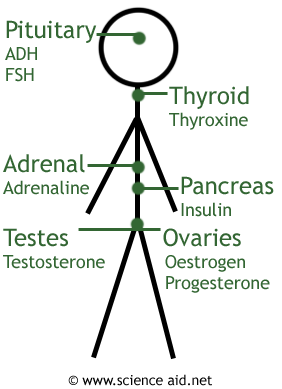Hormones: Location of Glands, Insulin, Oestrogen and Testosterone, Adrenaline
Edited by Jamie (ScienceAid Editor), Taylor (ScienceAid Editor)
Hormones
This system comprises of chemicals released from glands, directly into the blood stream that bring about changes. Hormonal reactions are more constant and longer lasting than nervous reactions.
Location of Glands
Oestrogen and Testosterone
While you were in the womb, oestrogen and testosterone were getting to work on either making you a boy or girl - so that a baby is born with sex organs. But around 12 years later, the real work begins. During puberty, the sex hormones (estrogen for females, testosterone for males) are produced in larger amounts, causing further changes called secondary sexual characteristics. These are:
Changes due to Estrogen
- 1Breasts develop.Advertisement
- 2Pubic hair grows.
- 3Hips widen.
- 4Menstruation begins.
Changes Due to Testosterone
- 1Body hair grows.
- 2Voice deepens.
- 3Muscles grow.
- 4Produce sperm.
The last two points for each hormone talk about stimulating growth of gametes (sex cells). This process is relatively simple in males, but for females it is continuous, as preparations must be made to the uterus for fertilization and involves a combination of different hormones.
Some women have poor fertility and so find it difficult to conceive a baby. To increase the ripening of the eggs, drugs containing FHS can be given. A Follicle Stimulating Hormone can also be given to induce the release of several eggs at a time, so they can be harvested for in vitro fertilization (more on this in genetics).
Adrenaline
The adrenal glands sit above the kidneys and produce the hormone adrenaline to prepare the body for physical activity, this is know as the 'fight-or-flight' response as it prepares you to stand up to, or run away from a lethal situation. This, of course, had an evolutionary benefit.
The rate and depth of breathing increases, this means there is more oxygen available to the muscles. Glycogen in the liver is converted into glucose to allow for increased respiration (opposite of what insulin does). Vasoconstriction (blood vessels get thinner) to skin and gut, and vasodilation to muscles so that more blood gets to them. This also will make you look pale and give you butterflies in the tummy.
Referencing this Article
If you need to reference this article in your work, you can copy-paste the following depending on your required format:
APA (American Psychological Association)
Hormones: Location of Glands, Insulin, Oestrogen and Testosterone, Adrenaline. (2017). In ScienceAid. Retrieved Apr 25, 2024, from https://scienceaid.net/biology/humans/hormones.html
MLA (Modern Language Association) "Hormones: Location of Glands, Insulin, Oestrogen and Testosterone, Adrenaline." ScienceAid, scienceaid.net/biology/humans/hormones.html Accessed 25 Apr 2024.
Chicago / Turabian ScienceAid.net. "Hormones: Location of Glands, Insulin, Oestrogen and Testosterone, Adrenaline." Accessed Apr 25, 2024. https://scienceaid.net/biology/humans/hormones.html.
If you have problems with any of the steps in this article, please ask a question for more help, or post in the comments section below.
Comments
Article Info
Categories : Humans
Recent edits by: Jamie (ScienceAid Editor)
